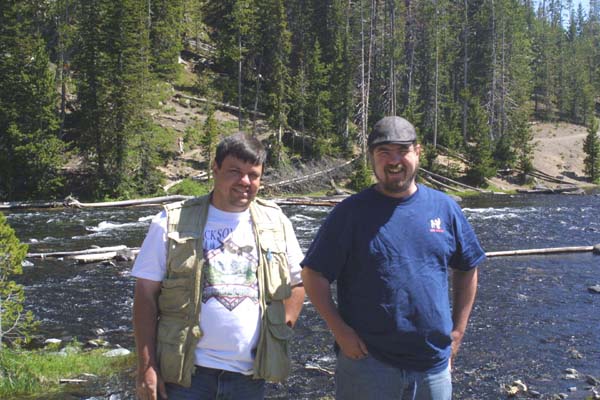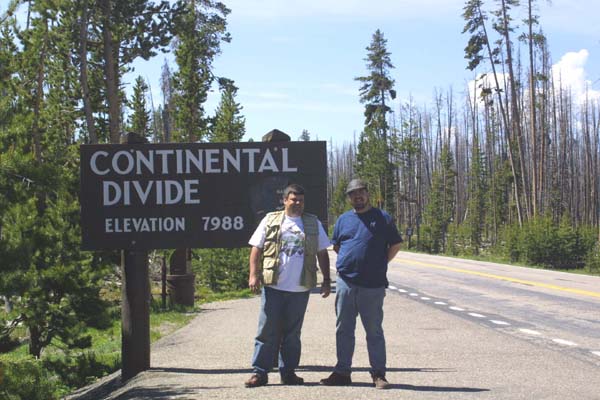
Do these clothes make us look....uh, heavy?

Have they gained weight?
| Back to Travel | Back to Yellowstone Home | Back to Home |
| Some of the Yellowstone lodgepole pines are coming up to replace their fallen comrades. In an interesting example of how life adapts, and how fire is a natural part of this ecosystem, the lodgepole pine cone is closed up tightly, completely sealing the seeds inside, so that they can not germinate. They only open in the presence of fire. | |
| The bridge past Lewis Falls. This stream is often full of fishermen, though there were none to be seen when this photo was taken. | |
| My trusty wagon. along with a number of other tourist conveyances, parked at the Lewis Falls lot. Some remnants of the great fires are still evident, as in this hill full of burned out patches. | |
| A close up of the formerly burned out hillside, shows much return of life. Note the small patch of snow at the top. The heights of Yellowstone were already considerably cooler than the surrounding areas. | |
| Lewis Falls. This is a very pretty area, and is the essence of a mountain stream. I wish that the picture could record the sound and smell of the water, along with the peace of this place. | |

|
It's those two middle aged guys from the steak house in Texas.
Do these clothes make us look....uh, heavy? |

|
They are back these guys seem to show up everywhere. This is their
second time across the Continental Divide.
Have they gained weight? |
| Our introduction to the West Thumb Geyser Basin. A sterile and strange looking place caught between the edge of the forest, and the edge of the water. | |
| A view of Yellowstone lake, over one of the many thermal pools in the West Thumb Geyser Basin. Note the sterile soil, and the walkway built around the pool. | |
| Some visitor skirt the edge of Abyss Pool. The lake is only yards away. | |
| Abyss Pool, with surrounding dead trees. Some steam can be discerned coming off the surface of the pool. Also notable are the differing colors, from blue in the deeper and hotter sections, to brown in the cooler sections, produced by different colored bacteria, which prefer to live in different temperature zones. | |
| A look down into the abyss, as it were. The pool opens up to large, deep subterranean structures. | |
| Plant life struggles for a tenuous foot hold here near the geyser basin. The calcite makes the soil sterile, and impenetrable by water. The hot water itself will kill any plant with which it may come into contact. | |
| Black Pool, rather poorly named now, but an accurate enough depiction of the pool's appearance when first discovered. The thermal features of the park are part of a dynamic system, and do change over time. In some cases the changes can be quite drastic. | |
| Geyser water drains off into Lake Yellowstone. The differing colors are less a matter of mineral deposits (which tends to be gray or white here), and more a matter of the different bacteria that thrive in the hot water. | |
| A stroll on the boardwalk. These walks are built over the thermal areas to prevent damage to the fragile structures and to keep tourists from injuring themselves. In many areas, there is just a thin crust of calcite, easily stepped through, over the scalding water. Visitors must stay on the walks. | |
| Some of the sterile lands around the geyser basin, almost appear to be a beach. This is not, however, sand. This is a more or less solid crust of calcite. | |
| Partly submerged under Yellowstone lake is the fishing hole geyser. On my first couple of trips out here, the cone was above water, but lake levels vary sometimes covering the little geyser over. There are some geysers, farther out, which are under a perpetual cover of lake water. | |
| Lake Yellowstone looking rather peaceful and prosaic under partly cloudy skies. The lake is subject to sudden rather violent storms. | |
| Seismograph Pool gets it's name from the fact that it acts up during, or just before earth tremors. It is also an indicator, somewhat, of eruptions of certain of the area's geysers. The temperature indicator shows that you would not want to put your hand in this pool. | |
| Seismograph Pool, looks a bit like an hour glass, from this angle. the steam coming off of it's far end is some indication of the heat being generated. | |
| The otherworldly appearance of a geyser basin. (West Thumb). | |
| Back To the Tetons | Forward To more of Yellowstone |